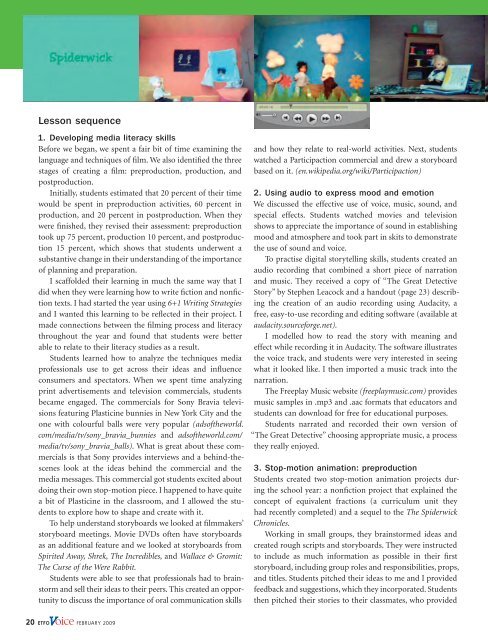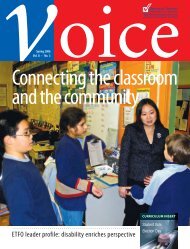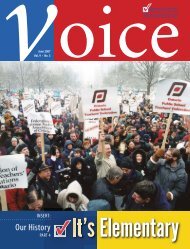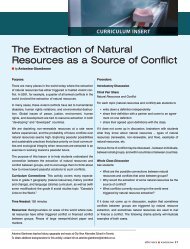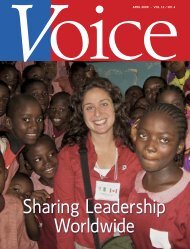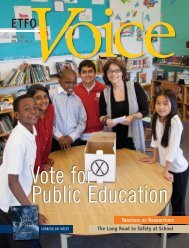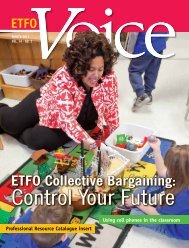Stop-Motion Animation - Digital Storytelling in the Classroom.pdf
Stop-Motion Animation - Digital Storytelling in the Classroom.pdf
Stop-Motion Animation - Digital Storytelling in the Classroom.pdf
You also want an ePaper? Increase the reach of your titles
YUMPU automatically turns print PDFs into web optimized ePapers that Google loves.
Lesson sequence<br />
1. Develop<strong>in</strong>g media literacy skills<br />
Before we began, we spent a fair bit of time exam<strong>in</strong><strong>in</strong>g <strong>the</strong><br />
language and techniques of film. We also identified <strong>the</strong> three<br />
stages of creat<strong>in</strong>g a film: preproduction, production, and<br />
postproduction.<br />
Initially, students estimated that 20 percent of <strong>the</strong>ir time<br />
would be spent <strong>in</strong> preproduction activities, 60 percent <strong>in</strong><br />
production, and 20 percent <strong>in</strong> postproduction. When <strong>the</strong>y<br />
were f<strong>in</strong>ished, <strong>the</strong>y revised <strong>the</strong>ir assessment: preproduction<br />
took up 75 percent, production 10 percent, and postproduction<br />
15 percent, which shows that students underwent a<br />
substantive change <strong>in</strong> <strong>the</strong>ir understand<strong>in</strong>g of <strong>the</strong> importance<br />
of plann<strong>in</strong>g and preparation.<br />
I scaffolded <strong>the</strong>ir learn<strong>in</strong>g <strong>in</strong> much <strong>the</strong> same way that I<br />
did when <strong>the</strong>y were learn<strong>in</strong>g how to write fiction and nonfiction<br />
texts. I had started <strong>the</strong> year us<strong>in</strong>g 6+1 Writ<strong>in</strong>g Strategies<br />
and I wanted this learn<strong>in</strong>g to be reflected <strong>in</strong> <strong>the</strong>ir project. I<br />
made connections between <strong>the</strong> film<strong>in</strong>g process and literacy<br />
throughout <strong>the</strong> year and found that students were better<br />
able to relate to <strong>the</strong>ir literacy studies as a result.<br />
Students learned how to analyze <strong>the</strong> techniques media<br />
professionals use to get across <strong>the</strong>ir ideas and <strong>in</strong>fluence<br />
consumers and spectators. When we spent time analyz<strong>in</strong>g<br />
pr<strong>in</strong>t advertisements and television commercials, students<br />
became engaged. The commercials for Sony Bravia televisions<br />
featur<strong>in</strong>g Plastic<strong>in</strong>e bunnies <strong>in</strong> New York City and <strong>the</strong><br />
one with colourful balls were very popular (adsof<strong>the</strong>world.<br />
com/media/tv/sony_bravia_bunnies and adsof<strong>the</strong>world.com/<br />
media/tv/sony_bravia_balls). What is great about <strong>the</strong>se commercials<br />
is that Sony provides <strong>in</strong>terviews and a beh<strong>in</strong>d-<strong>the</strong>scenes<br />
look at <strong>the</strong> ideas beh<strong>in</strong>d <strong>the</strong> commercial and <strong>the</strong><br />
media messages. This commercial got students excited about<br />
do<strong>in</strong>g <strong>the</strong>ir own stop-motion piece. I happened to have quite<br />
a bit of Plastic<strong>in</strong>e <strong>in</strong> <strong>the</strong> classroom, and I allowed <strong>the</strong> students<br />
to explore how to shape and create with it.<br />
To help understand storyboards we looked at filmmakers’<br />
storyboard meet<strong>in</strong>gs. Movie DVDs often have storyboards<br />
as an additional feature and we looked at storyboards from<br />
Spirited Away, Shrek, The Incredibles, and Wallace & Gromit:<br />
The Curse of <strong>the</strong> Were Rabbit.<br />
Students were able to see that professionals had to bra<strong>in</strong>storm<br />
and sell <strong>the</strong>ir ideas to <strong>the</strong>ir peers. This created an opportunity<br />
to discuss <strong>the</strong> importance of oral communication skills<br />
and how <strong>the</strong>y relate to real-world activities. Next, students<br />
watched a Participaction commercial and drew a storyboard<br />
based on it. (en.wikipedia.org/wiki/Participaction)<br />
2. Us<strong>in</strong>g audio to express mood and emotion<br />
We discussed <strong>the</strong> effective use of voice, music, sound, and<br />
special effects. Students watched movies and television<br />
shows to appreciate <strong>the</strong> importance of sound <strong>in</strong> establish<strong>in</strong>g<br />
mood and atmosphere and took part <strong>in</strong> skits to demonstrate<br />
<strong>the</strong> use of sound and voice.<br />
To practise digital storytell<strong>in</strong>g skills, students created an<br />
audio record<strong>in</strong>g that comb<strong>in</strong>ed a short piece of narration<br />
and music. They received a copy of “The Great Detective<br />
Story” by Stephen Leacock and a handout (page 23) describ<strong>in</strong>g<br />
<strong>the</strong> creation of an audio record<strong>in</strong>g us<strong>in</strong>g Audacity, a<br />
free, easy-to-use record<strong>in</strong>g and edit<strong>in</strong>g software (available at<br />
audacity.sourceforge.net).<br />
I modelled how to read <strong>the</strong> story with mean<strong>in</strong>g and<br />
effect while record<strong>in</strong>g it <strong>in</strong> Audacity. The software illustrates<br />
<strong>the</strong> voice track, and students were very <strong>in</strong>terested <strong>in</strong> see<strong>in</strong>g<br />
what it looked like. I <strong>the</strong>n imported a music track <strong>in</strong>to <strong>the</strong><br />
narration.<br />
The Freeplay Music website (freeplaymusic.com) provides<br />
music samples <strong>in</strong> .mp3 and .aac formats that educators and<br />
students can download for free for educational purposes.<br />
Students narrated and recorded <strong>the</strong>ir own version of<br />
“The Great Detective” choos<strong>in</strong>g appropriate music, a process<br />
<strong>the</strong>y really enjoyed.<br />
3. <strong>Stop</strong>-motion animation: preproduction<br />
Students created two stop-motion animation projects dur<strong>in</strong>g<br />
<strong>the</strong> school year: a nonfiction project that expla<strong>in</strong>ed <strong>the</strong><br />
concept of equivalent fractions (a curriculum unit <strong>the</strong>y<br />
had recently completed) and a sequel to <strong>the</strong> The Spiderwick<br />
Chronicles.<br />
Work<strong>in</strong>g <strong>in</strong> small groups, <strong>the</strong>y bra<strong>in</strong>stormed ideas and<br />
created rough scripts and storyboards. They were <strong>in</strong>structed<br />
to <strong>in</strong>clude as much <strong>in</strong>formation as possible <strong>in</strong> <strong>the</strong>ir first<br />
storyboard, <strong>in</strong>clud<strong>in</strong>g group roles and responsibilities, props,<br />
and titles. Students pitched <strong>the</strong>ir ideas to me and I provided<br />
feedback and suggestions, which <strong>the</strong>y <strong>in</strong>corporated. Students<br />
<strong>the</strong>n pitched <strong>the</strong>ir stories to <strong>the</strong>ir classmates, who provided<br />
20 etfo FEBRUARY 2009


